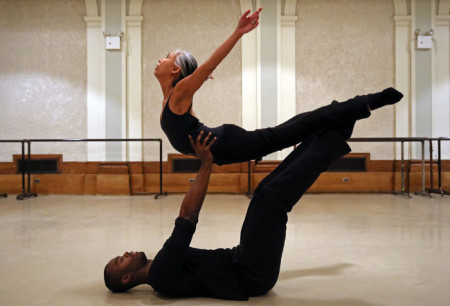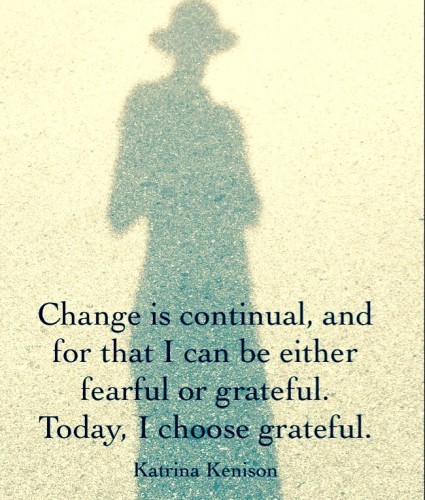expectations
 Before we can change anything in our life, we have to recognize that this is the way it is meant to be right now. For me, acceptance has become what I call the long sigh of the soul. It’s the closed eyes in prayer, perhaps even the quiet tears. It’s “all right,” as in “All right, You lead, I’ll follow.” And it’s “all right” as in “Everything is going to turn out all right.” This is simply part of the journey.
Before we can change anything in our life, we have to recognize that this is the way it is meant to be right now. For me, acceptance has become what I call the long sigh of the soul. It’s the closed eyes in prayer, perhaps even the quiet tears. It’s “all right,” as in “All right, You lead, I’ll follow.” And it’s “all right” as in “Everything is going to turn out all right.” This is simply part of the journey.
~ Sarah Ban Breathnach, from Simple Abundance
I was pretty confident I would be a kind of poster child for hip replacement recovery. I’m relatively young, not overweight, in decent shape for someone who’s been slowed down by advancing osteoarthritis for two years. In all that time, despite encroaching pain, I did my best to keep exercising. I continued my daily yoga practice, albeit a modified practice using blocks and a chair and bolsters. I waited a full year to see a highly recommended surgeon at one of the country’s best orthopedic hospitals. I scheduled my surgeries for 6 weeks apart at the end of 2105, so I could begin the new year with two new hips.
And I figured that if I followed instructions to the letter, did my physical therapy religiously, and didn’t push too far or too fast, I’d soon resume my old, normal life. Some people had warned, “This is major surgery.” But others said, “It’s no big deal.” Those were the ones I chose to believe. I was nervous, of course. But this had already been a long road. (I wrote about that here.) And within a few days of my second surgery, I had myself convinced I would negotiate this little patch of rough ground easily and soon be back on course with my life.
Yes, that’s called an “expectation.” And you’d think I’d know by now that getting attached to an expectation is a good recipe for disappointment.
About six weeks ago, I had to ask well-intentioned friends to stop sending me YouTube videos meant to lift my spirits and urge me on. There are plenty of inspiring hip replacement stories out there. I’ve watched the sixty year old woman doing yoga three weeks after her hip replacement. And the forty-eight–year-old former gymnast as she kicked her legs up around her shoulders without missing a beat.
 I marveled at the guy who threw his crutches away three days after surgery and was doing martial arts and kickboxing a few months later. I visited the website for post-op runners and read their stories of training for and completing marathons with bionic hips. The fifty-five-year-old Alvin Ailey dancer is gorgeous and amazing. As is the tap dancer. Yep, tap dancing, three weeks after surgery.
I marveled at the guy who threw his crutches away three days after surgery and was doing martial arts and kickboxing a few months later. I visited the website for post-op runners and read their stories of training for and completing marathons with bionic hips. The fifty-five-year-old Alvin Ailey dancer is gorgeous and amazing. As is the tap dancer. Yep, tap dancing, three weeks after surgery.
So impressive, every one of them. And so not my story.
Which is to say, I will not be joining the HipRunners club or sharing my recovery on dancerhips.com.
A few weeks after my second hip replacement, on the left side, I began to notice increasing pain and weakness in my left leg. Having already relegated my crutches to the basement, I retrieved them. The pain got worse. And then it became excruciating. X-rays showed there was nothing wrong with the new hardware and blood work confirmed there was no infection. And with that, my highly respected surgeon pretty much lost interest. “Take it easy,” he said.
The day after that appointment, I flew to Florida, fighting back tears with every step and dependent on the kindness of strangers to help me board the plane. My parents met me at the other end, surprised to see how much ground I’d lost. I’d planned this trip to their house here months ago, with the thought (the expectation) that by the time I arrived, I’d be almost back to “normal.” I pictured myself outside walking every day, adding miles, getting back to full speed.
Instead, for the first couple of weeks here, my mom took care of me. I spent hours those first days online, until I was finally able to diagnose myself: ischial bursitis. This debilitating inflammation can be caused by a discrepancy in leg length (check), extended periods of sitting (check), trauma to the region (check). There is no cure but rest and time, pain management, and then, eventually, exercises to begin to strengthen the atrophied muscles.
I’m better now. Most of the pain is gone. But it’s been almost three months since my last surgery, and I’m a long way from kicking up my heels. I still have weakness in my groin area. I have a limp. My left leg is shorter than my right, and that is something I’m going to have to live with. None of this is what I expected.
And so I’ve done a lot of thinking over these last weeks about expectations. I can certainly relate to Calvin and Hobbes creat0r Bill Watterson’s line, “I find my life is a lot easier the lower I keep my expectations.”
Because, really, so much of the disappointment we experience in life has to do with the gap between the way we think something ought to be and the reality of what actually pans out. In retrospect, I wish I hadn’t watched all those videos of the hip replacement superstars. I might have had an easier time, psychologically anyway, if I’d set out down this path with a bit less ego and expectation, and with more humility and curiosity instead. Bodies are unpredictable, after all, and surgery is an art not a science. There are no guarantees.
And so, I come to the end of this long-awaited time in Florida with new perspective on the process of healing. The physical setback meant I had no choice but to go into one-day-at a-time mode. And having to readjust all my expectations brought me to a place I didn’t expect to be: starting over again at square one. Instead of sailing through these surgeries and the aftermath with flying colors, I sat on the edge of the bed here at my parents house six weeks ago and wondered how I was going to lift my foot high enough to get my underpants on.
“In the beginner’s mind there are many possibilities,” observes Zen master Shunryu Suzuki, “but in the expert’s there are few.”
Pain makes you a beginner. Moment by moment, day by day, you learn what your body will tolerate. You figure out what helps and what movements to avoid at all costs. And suddenly, with pain as your teacher, you are really, really awake and really, really paying attention. Simple movements that you once did mindlessly – carrying the tea kettle to the stove, getting into a car, standing up from the toilet – demand the kind of awareness and integrity you used to bring to an advanced yoga pose you were trying for the first time.
 I’ve had nearly two months in this lovely house with a pool and a hot tub overlooking a canal. I’ve had time with my mom, time with Henry, and now, before Steve joins me for a short vacation, I have two utterly quiet weeks all alone. I’ve had hours each day to stretch, to do exercises in the water, and to experiment on my yoga mat, slowly rebuilding strength and flexibility. What I’ve accomplished wouldn’t make for much of a video, but it feels like progress to me. Both of my legs are getting stronger. And I’ve also learned a few hard lessons about releasing expectations.
I’ve had nearly two months in this lovely house with a pool and a hot tub overlooking a canal. I’ve had time with my mom, time with Henry, and now, before Steve joins me for a short vacation, I have two utterly quiet weeks all alone. I’ve had hours each day to stretch, to do exercises in the water, and to experiment on my yoga mat, slowly rebuilding strength and flexibility. What I’ve accomplished wouldn’t make for much of a video, but it feels like progress to me. Both of my legs are getting stronger. And I’ve also learned a few hard lessons about releasing expectations.
When it comes to my body now, I have to accept that there’s much I can’t control. What I can do instead is attend to it. The difference is major. Attending means listening, observing, accepting. It means working with what is rather than grasping for something out of reach. The path to wellness turns out to be more mysterious and unpredictable than I knew, which makes it scarier and more confusing. But it also makes it beautiful. Because as pain slowly eases its grip, what comes seeping into that tender place is gratitude.
 Yesterday, I took my first real walk outside without using hiking poles for support. It felt like liberation – and like cause for celebration. I walked slowly, thinking about every step, carefully placing heels and toes, focusing on creating a smooth gait. And what I thought about wasn’t that I’m not running or dancing or executing pigeon poses on my yoga mat. I thought about how fabulous it felt to take a walk.
Yesterday, I took my first real walk outside without using hiking poles for support. It felt like liberation – and like cause for celebration. I walked slowly, thinking about every step, carefully placing heels and toes, focusing on creating a smooth gait. And what I thought about wasn’t that I’m not running or dancing or executing pigeon poses on my yoga mat. I thought about how fabulous it felt to take a walk.
I watched the sky change colors and the clouds turn golden as the sun sank away. I listened to the mourning doves calling back and forth from their perches on the utility wires above my head. I felt the breeze on my skin and the long muscles in my inner thighs that still need strengthening and the awkwardness of having legs that don’t quite match up. But I also felt like myself. Not the old self, who used to run through these neighborhoods, pounding the pavement and dripping sweat, but me, nonetheless: present, in my body, in the world, and still moving. Oh, and happy.
The post expectations appeared first on Katrina Kenison.
 newest »
newest »
 HI Cara, A belated thank you for sharing your story here. I, too, miss running more than I can say. So everything you write resonates deeply with me. But I'm so glad that you, too, are able to find the beauty in the slow lane. Love your phrase about "exercising away my feelings." Perfect. And now we both have to sit with our feelings, which is quite a challenge. A worthy one though. Hope your foot is healing. best, Katrina
HI Cara, A belated thank you for sharing your story here. I, too, miss running more than I can say. So everything you write resonates deeply with me. But I'm so glad that you, too, are able to find the beauty in the slow lane. Love your phrase about "exercising away my feelings." Perfect. And now we both have to sit with our feelings, which is quite a challenge. A worthy one though. Hope your foot is healing. best, Katrina




What I'm finding so amazing about this frustrating experience is that it's forcing me inward. I'm slowing down physically and can't just exercise away my feelings. I have to sit with them. It's been good. Can't say I like it, but as you pointed out - pain changes everything. It levels us a bit and makes us beginners.
Enjoyed this post (and all of them although I never used to have time to sit still to comment on them!).
Thanks for helping me see the good in this. Hope you are healing more with every step.